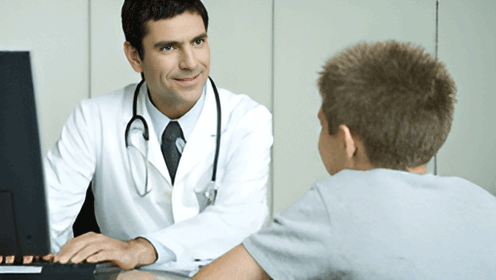Colonoscopy, Sigmoidoscopy, and Polyps
ColonoscopyIndications for Colonoscopy
Sigmoidoscopy
Polyps of the Colon and Rectum
Are polyps dangerous?
Who gets polyps?
What are the symptoms?
How does the doctor test for polyps?
Who should get tested for polyps?
How are polyps treated?
How can I prevent polyps?
Points to remember
Colonoscopy (koh-luh-NAH-skuh-pee) lets the physician look inside your entire large intestine, from the lowest part, the rectum, all the way up through the colon to the lower end of the small intestine. The procedure is used to diagnose the causes of unexplained changes in bowel habits. It is also used to look for early signs of cancer in the colon and rectum. Colonoscopy enables the physician to see inflamed tissue, abnormal growths, ulcers, bleeding, and muscle spasms.

For the procedure, you will lie on your left side on the examining table. You will probably be given pain medication and a mild sedative to keep you comfortable and to help you relax during the exam. The physician will insert a long, flexible, lighted tube into your rectum and slowly guide it into your colon. The tube is called a colonoscope (koh-LON-oh-skope). The scope transmits an image of the inside of the colon, so the physician can carefully examine the lining of the colon. The scope bends, so the physician can move it around the curves of your colon. You may be asked to change position occasionally to help the physician move the scope. The scope also blows air into your colon, which inflates the colon and helps the physician see better.

If anything unusual is in your colon, like a polyp or inflamed tissue, the physician can remove a piece of it using tiny instruments passed through the scope. That tissue (biopsy) is then sent to a lab for testing. If there is bleeding in the colon, the physician can pass a laser, heater probe, or electrical probe, or inject special medicines, through the scope and use it to stop the bleeding.
Bleeding and puncture of the colon are possible complications of colonoscopy. However, such complications are uncommon.
Colonoscopy takes 30 to 60 minutes. The sedative and pain medicine should keep you from feeling much discomfort during the exam. You will need to remain at the physician's office for 1 to 2 hours until the sedative wears off.
Indications for ColonoscopyAccording to the STOP Colon/Rectal Cancer Foundation: · Beginning at age 50, you should have a screening colonoscopy every 10 years. If you are completely asymptomatic (without any symptoms) and you have no history of colorectal disease, you still need to be screened.
· Beginning at age 40 or earlier, you should have a colonoscopy if you have a personal or family history of benign colorectal polyps, colorectal cancer, ovarian cancer, uterine cancer, breast cancer, ulcerative colitis or Crohn's disease.
SigmoidoscopyA flexible sigmoidoscopy (SIG-moy-DAH-skuh-pee) exam is a short colonoscopy exam, limited to the lower one third of the colon. Sigmoidoscopy enables the physician to look at the sigmoid colon. Physicians may use this procedure to find the cause of diarrhea, abdominal pain, or constipation. They also use sigmoidoscopy to look for early signs of cancer in the colon and rectum. With sigmoidoscopy, the physician can see bleeding, inflammation, abnormal growths, and ulcers.


Sigmoidoscopy takes 10 to 20 minutes. During the procedure, you might feel pressure and slight cramping in your lower abdomen. You will feel better afterwards when the air leaves your colon.
The discovery of a polyp on flexible sigmoidoscopy necessitates a complete colon inspection with a colonoscope, since at least 30 percent of these patients will have additional polyps.
Polyps of the Colon and Rectum

Colon Polyps
A Polyp (POL-ip) is any mass of abnormal tissue that bulges or projects outward or upward from a surface of the colon or rectum by growing from a broad base (sessile) or slender stalk (pedunculus). The early detection and removal of polyps prevent colon and rectal cancer.
Finding polyps early can reducethe risk of cancer by up to 90%
Polyps are one of the most common conditions affecting the colon and rectum, occurring in 15-20 percent of the adult population. Although most polyps are benign, the relationship of certain polyps to cancer is well established. Are polyps dangerous?Most polyps are not dangerous. Most are benign, which means they are not cancer. But over time, some types of polyps can turn into cancer. Usually, polyps that are smaller than a pea aren't harmful. But larger polyps could someday become cancer or may already be cancer. To be safe, doctors remove all polyps and test them.

Colon Polyp
You may also be more likely to get polyps if you
- eat a lot of fatty foods
- smoke
- drink alcohol
- don't exercise
- weigh too much

Find out if someone in your family has had polyps.
Most small polyps don't cause symptoms. Often, people don't know they have one until the doctor finds it during a regular checkup or while testing them for something else.
But some people do have symptoms like these:
- bleeding from the anus. You might notice blood on your underwear or on toilet paper after you've had a bowel movement.
- constipation or diarrhea that lasts more than a week.
- blood in the stool. Blood can make stool look black, or it can show up as red streaks in the stool.
If you have any of these symptoms, see a doctor to find out what the problem is.
How does the doctor test for polyps?The doctor can use four tests to check for polyps:
- Digital rectal exam. The doctor wears gloves and checks your rectum, the last part of the large intestine, to see if it feels normal. This test would find polyps only in the rectum, so the doctor may need to do one of the other tests listed below to find polyps higher up in the intestine.
- Barium enema. The doctor puts a liquid called barium into your rectum before taking x rays of your large intestine. Barium makes your intestine look white in the pictures. Polyps are dark, so they're easy to see.
- Sigmoidoscopy. With this test, the doctor can see inside your large intestine. The doctor puts a thin flexible tube into your rectum. The device is called a sigmoidoscope, and it has a light and a tiny video camera in it. The doctor uses the sigmoidoscope to look at the last third of your large intestine.
- Colonoscopy. This test is like sigmoidoscopy, but the doctor looks at all of the large intestine. It usually requires sedation.

Colonoscopy or sigmoidoscopy testing

Talk to your doctor about getting tested for polyps if
- you have symptoms
- you're 50 years old or older
- someone in your family has had polyps or colon cancer
How are polyps treated?
The doctor will remove the polyp. Sometimes, the doctor takes it out during sigmoidoscopy or colonoscopy. Or the doctor may decide to operate through the abdomen. The polyp is then tested for cancer.
If you've had polyps, the doctor may want you to get tested regularly in the future.
 Polyp removal
Polyp removal
Doctors don't know of any one sure way to prevent polyps. But you might be able to lower your risk of getting them if you
- eat a high fiber diet, (i.e. more fruits and vegetables) and less fatty food.
- don't smoke
- avoid alcohol
- exercise every day
- lose weight if you're overweight
Eating more calcium and folate can also lower your risk of getting polyps. Some foods that are rich in calcium are milk, cheese, and broccoli. Some foods that are rich in folate are chickpeas, kidney beans, and spinach.

- A polyp is extra tissue that grows inside the body. Most polyps are not harmful.
- Symptoms may include constipation or diarrhea for more than a week or blood on your underwear, on toilet paper, or in your stool.
- Many polyps do not cause symptoms.
- Doctors remove all polyps and test them for cancer.
- Talk to your doctor about getting tested for polyps if
- you have any symptoms
- you're 50 years old or older
- someone in your family has had polyps or colon cancer
Most colon examinations using the flexible colonoscope, including polyp removal, can be performed on an outpatient basis with minimal discomfort. Large polyps may require more than one treatment for complete removal. Some polyps cannot be removed by instruments because of their size or position; surgery is then required.
Once a polyp is completely removed, its recurrence is very unusual. However, the same factors that caused the polyp to form are still present. New polyps will develop in at least 30 percent of people who have previously had polyps. Patients should have regular exams by a physician specially trained to treat diseases of the colon and rectum.









